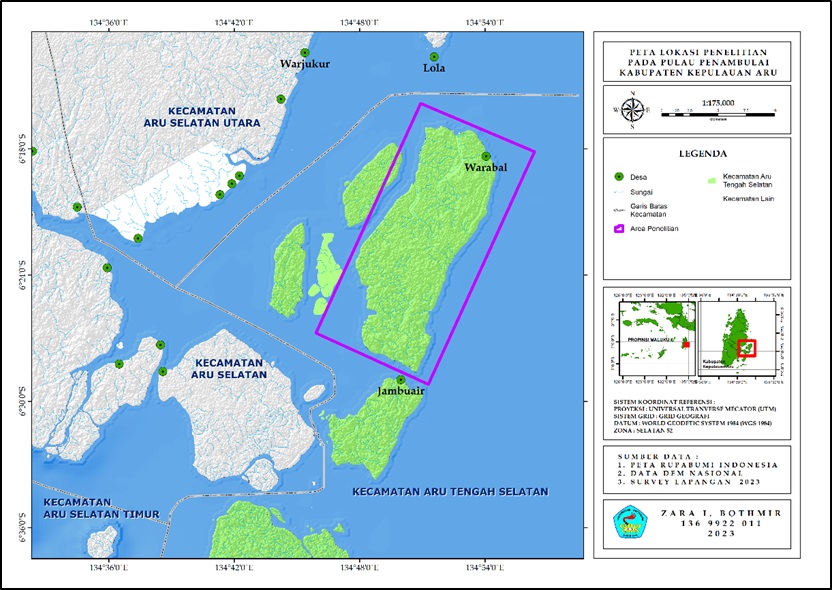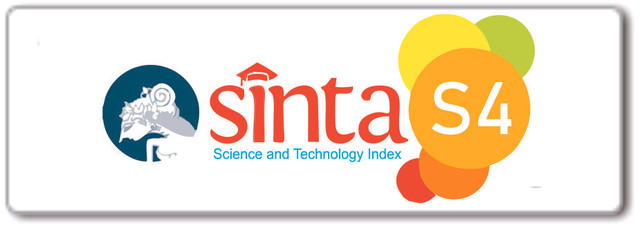The Potential of coral reefs at Penambulai Island, Aru Islands Regency
Abstract
Penambulai Island, one of the 676 islands in the Aru Islands Regency, is one of Indonesia's outermost small islands and has the status of a Certain National Strategic Area. The coral reefs on this island have been under pressure from human activities and climate influences. Research in the waters of Penambulai aims to analyze the potential of coral reefs. The research was conducted in August 2023. Data collection used the LIT method and data analysis used the English (1997) percent cover formula and the Standard criteria for coral reef damage and condition. The coral reefs around Penambulai Island are extensive, covering over 1,000 hectares. The majority of the reef area (73.76%) is comprised of living organisms, which is a good sign. Hard corals, a crucial reef-building organism, have a significant presence (42.04%). The reef exhibits high species diversity with 51 hard coral species belonging to various families and genera. Despite these positive aspects, the overall health of the coral reefs is considered "moderate" due to natural stressors.
Downloads
References
English, S., Wilkinson, C., & Baker, V. 1997. Survey manual for tropical marine resources.
Faizal, I., & Yuanita, N. 2017. Study of coral reef ecosystem vulnerability using sediment transport modeling in Bungus Bay, West Sumatera. International Journal of Science and Research, 6(6), 176-180.
Isdianto, A. 2022. Hubungan parameter hidro-oseanografi dengan tutupan karang di Perairan Selat Sempu. JFMR, 6(3), 45-53.
Kjerfve, R., McField, M., Thattai, D., & Giro, A. 2021. Coral reef health in the Gulf of Honduras in relation to fluvial runoff, hurricanes, and fishing pressure. Marine Pollution Bulletin, 172, 112865.
Minister of Environment. 2021. Minister of Environment Decree Number 4 of 2001.
Muhaemin, M., Arifin, T., Mahdafikia, N,. & Fihrin, H. 2022. Pengaruh parameter oseanografi fisik terhadap indikasi pemutihan karang (coral bleaching) di Taman Wisata Perairan (TWP) Kapoposang Spermonde Selat Makasar. Journal of Marine Research, 11(4), 587-597.
Ouedraogo, D. Y., Delaunay, M., Sordello, R., Hedouin, L., Castelin, M., Perceval, O., ... & Reyjol, Y. 2021. Evidence on the impacts of chemicals arising from human activity on tropical reef-building corals; a systematic map. Environmental Evidence, 10, 1-18.
Prasetyo, A. B., & Yuliadi, L. P. S. 2018. Keterkaitan tipe substrat dan laju sedimentasi dengan kondisi tutupan terumbu karang di Perairan Pulau Panggang, Taman Nasional Kepulauan Seribu. Jurnal Perikanan Kelautan, 9(2).
Presidential Regulation. (2016). Presidential Regulation Number 6 of 2016 Concerning the Designation of Small Outer Islands.
Presidential Regulation. (2021). Presidential Regulation Number 26 of 2021 Concerning the Designation of Certain National Strategic Areas.
Sahetapy, D. 2003. Struktur komunitas karang di perairan pesisir Pulau Larat, Kabupaten Maluku Tenggara Barat. TRITON: Jurnal Manajemen Sumberdaya Perairan, 2(1), 83-88.
Sahetapy, D., & Far-Far, R. 2008. Kondisi terumbu karang di perairan pesisir pulau-pulau kecil Kecamatan Gorom, Kabupaten Seram bagian Timur. Prosiding KONAS VI, 474-485.
Sahetapy, D. (2015). Kondisi terumbu karang di perairan pesisir dan pulau-pulau kecil, Kabupaten Kepulauan Aru Provinsi Maluku. Prosiding Pertemuan Ilmiah Tahunan (PIT) XI ISOI, 236-254.
Sahetapy, D., Siahainenia, L., Selano, D. A., Teelepta, J. M., & Tuhumury, N. 2021. Status terumbu karang di perairan pesisir Negeri Hukurila. TRITON: Jurnal Manajemen Sumberdaya Perairan, 17(1): 35-45.
Sahetapy, D., Limon, G. V., Tetelepta, J. M. S., Pattikawa, J. A., Rijoly, F., Masrikat, J. A. N., & Loupatty, S. R. 2021. Coral reef condition in the coastal waters of Kei Besar Island, Southeast Maluku-Indonesia. IOP Conference Series: Earth and Environmental Science, 805(1), 012002.
Setiawan, F., Muttaqin, A., Tarigan, S. A., Muhidin, M., Hotmariyah, H., Sabil, A., & Pinkan, J. 20217. Coral bleaching impact in 2016 towards coral reef ecosystem: Case studies TWP Gili Matra (Gili Air, Gili Meno and Gili Trawangan). Jurnal Kelautan: Indonesian Journal of Marine Science and Technology, 10(2), 147-161.
Susanto, H. A., Suraji, T. M., & Tokeshi, M. 2015. Management of coral reef ecosystems in Indonesia: Past, present, and the future. Coast Ecosyst, 2, 21-41.
Westmacott, S., Cesar, H. S., Pet-Soede, L., & Linden, O. 2000. Coral bleaching in the Indian Ocean: Socio-economic assesment of affects. Essays on the Economics of Coral Reefs. HSJ Cesar (ed), 94-106.

Copyright (c) 2024 James Abrahamsz

This work is licensed under a Creative Commons Attribution-NonCommercial-ShareAlike 4.0 International License.
Authors who publish with BIOEDUPAT: Pattimura Journal of Biology and Learning agree to the following terms:
- Authors retain copyright and grant the journal right of first publication with the work simultaneously licensed under a Creative Commons Attribution License (CC BY-NC-SA 4.0) that allows others to share the work with an acknowledgment of the work's authorship and initial publication in this journal.
- Authors are able to enter into separate, additional contractual arrangements for the non-exclusive distribution of the journal's published version of the work (e.g., post it to an institutional repository or publish it in a book), with an acknowledgment of its initial publication in this journal.
- Authors are permitted and encouraged to post their work online (e.g., in institutional repositories or on their website) prior to and during the submission process, as it can lead to productive exchanges, as well as earlier and greater citation of published work.








 This work is licensed under a
This work is licensed under a 